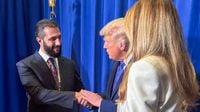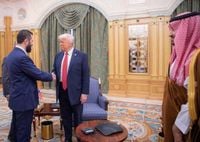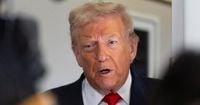For the first time in American history, a sitting Syrian president will visit the White House. President Donald Trump is set to host Ahmad al-Sharaa for high-stakes talks in Washington, D.C. on November 10, 2025, a move that could signal a dramatic shift in the diplomatic landscape of the Middle East. The news, first reported by Axios and confirmed by multiple outlets including the Associated Press and i24NEWS, was announced by a U.S. administration official on November 1.
This unprecedented meeting comes as Syria attempts to step out from the shadow of more than five decades of international isolation and authoritarian rule under the Assad family. Al-Sharaa’s visit is not only historic—it also marks a moment of intense scrutiny, given his controversial past and the region’s fragile state.
Al-Sharaa, who assumed the presidency following the collapse of the Assad regime, is a figure whose biography reads like a thriller. Once known under the nom de guerre Abu Mohammed al-Golani, he had deep ties to al-Qaida and fought alongside insurgents against U.S. forces in Iraq. At one point, the U.S. government placed a $10 million bounty on his head. He was ultimately captured and imprisoned by American troops in Iraq for several years before returning to Syria to become a prominent player in the country’s civil conflict, according to the Associated Press.
The November 10 summit will be the first time a Syrian leader has set foot in the White House. The last direct engagement between the two nations’ leaders dates back a quarter-century, when Hafez Assad met President Bill Clinton in Geneva in 2000. Trump and al-Sharaa had their first face-to-face encounter in May 2025 during a summit in Saudi Arabia, which was itself a diplomatic milestone after 25 years of frosty relations. That meeting, held on the sidelines of a gathering with Gulf Cooperation Council leaders, was widely interpreted as a turning point for Syria as it sought to rejoin the international community.
In the months since, al-Sharaa has continued his push for legitimacy on the world stage. According to i24NEWS, he attended the United Nations General Assembly in September, becoming the first Syrian leader in nearly 60 years to participate in such a high-level UN meeting. There, he reiterated his government’s commitment to dialogue and regional stability, particularly regarding Israel. "In response, Syria will use dialogue and diplomacy to overcome this crisis and pledge its commitment to the 1974 Disengagement Agreement," al-Sharaa stated, referencing the longstanding accord with Israel that governs the two nations’ military positions along the Golan Heights.
The upcoming White House visit is expected to include the signing of an agreement that would see Syria join the U.S.-led coalition against ISIS, according to administration officials cited by the Associated Press. Such a move would represent a significant about-face for al-Sharaa, given his past as a militant adversary of the United States. It also comes at a time when the region is searching for stability after years of violence and upheaval.
The context for this diplomatic thaw is as complex as it is precarious. The meeting will take place against the backdrop of a recently brokered ceasefire and hostage exchange deal between Israel and Hamas, which began on October 10, 2025. President Trump has been urging Middle Eastern allies to seize the opportunity to forge a lasting peace in a region long defined by conflict. The ceasefire, however, remains fragile. Just this past week, Israeli airstrikes in Gaza claimed the lives of 104 people, including dozens of women and children, according to Gaza health authorities. These strikes, the deadliest since the truce began, followed Israeli accusations that Hamas had killed a soldier and staged the discovery of a deceased hostage.
The timing of al-Sharaa’s visit is therefore highly significant. It not only underscores the Trump administration’s efforts to build new alliances in the region but also reflects Syria’s desire to break free from its pariah status. After more than 50 years of Assad family dominance—marked by brutality, repression, and civil war—Syria is now adjusting to a new era. Al-Sharaa’s emergence as a leader, given his militant history, is both a symbol of the country’s turbulent past and a test of its possible future.
For many in Washington and beyond, the prospect of welcoming a former jihadist to the White House is controversial, to say the least. Al-Sharaa’s transformation from insurgent commander to head of state is the subject of both skepticism and cautious optimism. Supporters argue that engaging with Damascus could help stabilize the region, especially if Syria commits to fighting extremist groups and respecting international agreements. Critics, however, warn that legitimizing al-Sharaa could backfire, given his history and the lingering distrust between Syria and the West.
Al-Sharaa, for his part, has sought to reassure the international community of his intentions. During his recent UN appearance, he emphasized Syria’s commitment to dialogue, diplomacy, and the 1974 disengagement agreement with Israel. These pledges, while encouraging, will be tested in the coming months as Syria’s actions speak louder than words.
The November 10 meeting is also expected to address the broader question of Syria’s reintegration into global institutions and alliances. With the country still reeling from years of civil war, economic collapse, and humanitarian crisis, the path forward is anything but clear. Yet the symbolism of a Syrian president walking the halls of the White House cannot be overstated. It represents a potential new chapter—not just for Syria, but for the entire Middle East.
As the date approaches, anticipation and anxiety continue to build. Will this meeting mark the start of a genuine rapprochement, or will old grievances and suspicions prevail? The world will be watching as Trump and al-Sharaa sit down in Washington—a moment that, for better or worse, could help shape the region’s future.
Whatever the outcome, one thing is certain: the shadow of history looms large over the White House this November, as the United States and Syria attempt to chart a new course after decades of conflict and estrangement.



